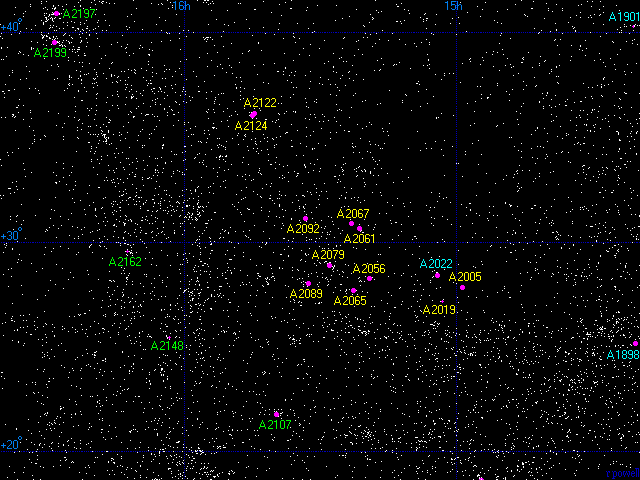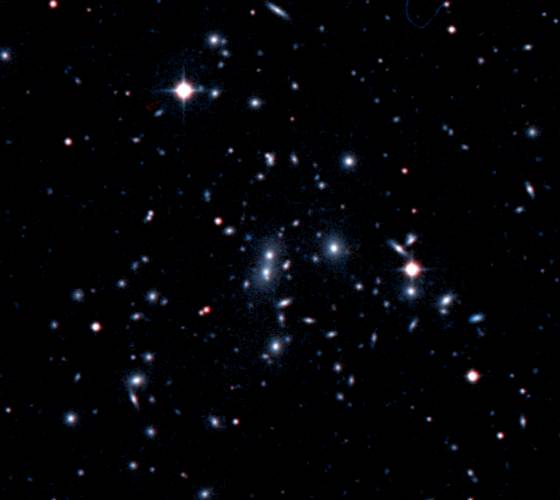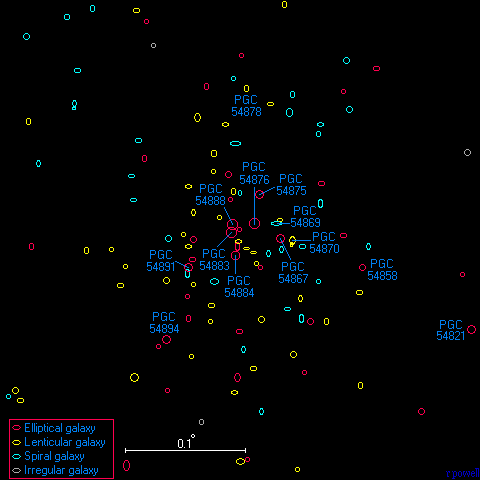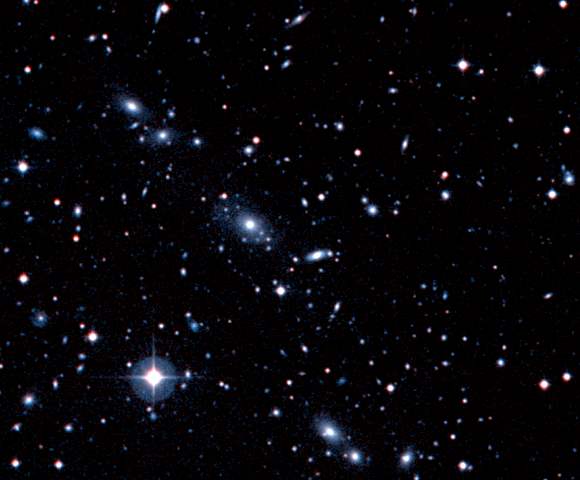
Although it is one billion light years from us, the Corona Borealis supercluster is famous because it is a fairly obvious concentration of clusters of galaxies. This map shows every galaxy brighter than magnitude 17 (from the HyperLeda database) in this area of the sky. The locations of the major clusters of galaxies in the Corona Borealis supercluster are marked in the centre. On the left side of the map lies part of the Hercules supercluster at about half the distance.

Below is a list of the Corona Borealis Supercluster clusters. A2065 is the most famous of these clusters although a lot of the other clusters here are also quite rich. Two of these clusters, A2122 and A2124, are actually the same cluster. A2124 is the center of the cluster and A2122 is an extension of it.
1 2 3 4 5 6 7
Abell Equatorial Redshift Distance Rich Notes
Number Coordinates z Mly
RA Dec
A2005 14 58.7 +27 49 .0762 1025 2
A2019 15 03.0 +27 11 .0795 1065 0
A2022 15 04.3 +28 25 .0566 770 1 foreground cluster
A2056 15 19.2 +28 16 .0834 1115 1
A2061 15 21.3 +30 39 .0772 1035 1
A2065 15 22.7 +27 43 .0714 960 2 Corona Borealis cluster
A2067 15 23.2 +30 54 .0736 990 1
A2079 15 28.1 +28 53 .0649 875 1
A2089 15 32.7 +28 01 .0720 970 1
A2092 15 33.3 +31 09 .0657 890 1
A2122 15 44.5 +36 08 .0649 875 1
A2124 15 45.0 +36 04 .0649 875 1
|
Column 1: The name/number of the cluster.
Column 2: The Right Ascension for epoch 2000.
Column 3: The Declination for epoch 2000.
Column 4: The redshift of the cluster.
Column 5: The distance in millions of light years assuming H=70km/s/Mpc.
Column 6: The 'richness' class of the cluster.
Column 7: Additional names and notes.
References:
Abell G, Corwin H, Olowin R, (1989), A catalogue of Rich Clusters of Galaxies,
Astrophys J Supp, 70, 1.
Struble M, Rood H, (1999), A compilation of redshifts and velocity dispersions for
ACO clusters, Astrophys J, 125, 35.
Below is a picture of the centre of the A2065 cluster. This cluster is often called the Corona Borealis cluster. It is the richest cluster of galaxies in the Corona Borealis supercluster. This cluster is famous mainly because it was one of several clusters used by Milton Humason and Edwin Hubble in the 1930's to demonstrate that the universe is expanding.


This is a map of the A2065 cluster. This map shows 119 of the brightest galaxies in this cluster. A lot of the galaxies in this cluster have not been accurately classified, so some of the classifications used in this map are probably wrong, although it is clearly a cluster which contains a wide variety of different galaxy types.
The possibility that there might be a supercluster in Corona Borealis was first suggested in the 1950's. George Abell examined his own catalogue of Rich Clusters of Galaxies (published in 1958) and in a paper published in 1961, he included the Corona Borealis supercluster as supercluster number 13 in a list of 17 possible superclusters.
The first proper study of the Corona Borealis supercluster was published by M Postman, M Geller and J Huchra in 1988. They studied the motion of seven of the clusters in the supercluster, and they estimated the mass of the supercluster.
More recently, in 1997 and 1998, T Small, C Ma, W Sargent and D Hamilton, published three papers about this supercluster (1, 2, 3). They noticed the presence of another supercluster behind the Corona Borealis supercluster (associated with A2034, A2049, A2062, A2069 and A2083) at a distance of 1.5 billion light years (redshift 0.113). They also believe that the clusters at the centre of the Corona Borealis supercluster are collapsing together and will eventually form one big cluster.
F Kopylova and A Kopylov agree with them. They published evidence in 1998 that the core of the supercluster (consisting of A2061, A2065, A2067, A2089 and A2092) is "in a stage of rapid gravitational collapse," (on a timescale of billions of years).
The Corona Borealis cluster (A2065) was discovered by Edwin Hubble in the 1930's. In 1936, Milton Humason measured the redshift of one of the galaxies (PGC 54876) in the cluster as part of a project to demonstrate that velocity is proportional to distance for a large number of distant clusters. This was powerful evidence that the universe is expanding.
Below - a picture of the A2061 cluster. This is another of the rich clusters of galaxies in the Corona Borealis supercluster. The large elliptical galaxy near the centre is PGC 54787.
